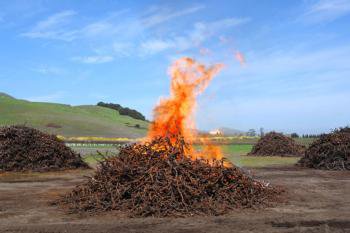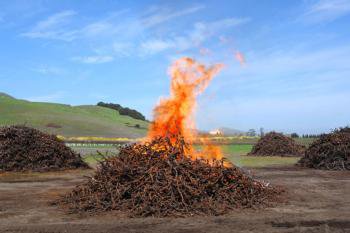Farmers, when Jan. 1, 2025 rolls around, will no longer be able to burn almond tree, vineyard trimmings, and such.
It is the decree handed down by the California Air Resources Board. The order applies to almost all agricultural burning in the San Joaquin Valley.
In case you haven’t noticed we live in either the nation’s worst — or one of the top worst — air basins depending upon what type of pollution you are taking about.
But we also need to be clear on one point. We are never going to attain the air quality that federal government agencies headquartered on the wind-swept Atlantic Seaboard have decreed we must ultimately reach.
There is a reason for this. The Great Central Valley is one of the biggest natural bowls on earth. It is 450 miles long stretching from Redding to just south of Bakersfield with a width that varies from 40 to 60 miles. It is hemmed in by the Coastal Range, the Cascades, the Sierra and the Tehachapi mountains.
We also have done a lot of improvements when it comes to air quality. Back in the 1970s the air quality in the Sacramento Valley sometimes resembled the worst you can still experience in Kern County on a still summer day when all of the wrong conditions in place.
Today air quality without the added mix of wildfires never gets that bad in the Sacramento Valley. And while it has improved in the San Joaquin Valley, we can do better.
Some levels of air quality elements have improved by more than 50 percent in the San Joaquin Valley while the population of the eight-county region has increased by 50 percent.
It’s a day and night difference on most days in San Joaquin County and Stanislaus County as well.
But there is one fact that can’t be disputed. The farther south you head toward Kern County the worse air quality becomes. There are some days traveling Highway 99 through Bakersfield that you can’t see the Sierra that sharply rises in the east just 15 miles away.
At the same time it is clear we can’t attain air quality in several areas those in Washington, D.C., who munch on almonds or eat a healthy salad with a fruit dish on the side say we need to do here in the valley that helps fill their stomachs.
The San Joaquin Valley Air Quality District a few years back pointed out you could remove all vehicles, farm, construction equipment, trains, and trucks from the region and you still would not be able to attain what the federal government wants.
Part of the problem is what the wind blows in. A while back when there was a fierce argument in Sacramento whether Bay Area countries should follow the same higher restrictions for smog checks required for vehicles registered in the valley, the state Air Resources Board did a study.
It showed a significant percentage of air pollution in San Joaquin County blew in through the Carquinez Straits and Altamont Pass. As you head south the percentage of “Bay Area” pollution blown into each county dropped. By the time you reached Kern County it was down to single digits.
By no way does this mean the valley gets a pass on not working toward cleaner air. But it underscores the fact the goal may not be attainable.
Those that have lived in San Joaquin County will tell you the air is a lot cleaner today than it was 30 to 40 years ago.
A study IQAir Group released last week showed particulate matter pollution dropped by strong double digits during 2020 in many urban areas around the globe. The pandemic economic lockdown was the reason. A few even have theorized it is what could happen worldwide if fossil fuel power plants and vehicles disappeared from the face of the earth.
There was a huge asterisk, however. Those areas impacted by wildfires saw particulate matter pollution explode.
And nowhere was it as bad as in the Great Central Valley that got hit with the brunt of the record 4.3 million acres that burned in California wildfires.
The fact wildfires eliminate all gains and then some is not a reason to retreat on air quality goals that are reasonable.
And as much as some like to blame farmers for all perceived environmental woes, good luck fending off mass starvation, nutritional calamity, and skyrocketing food prices by putting farmers — or more precisely — small farmers out of business due to cost prohibitive air quality mandates.
We cannot lose sight of the fact California’s 77,000 farms grow 50 percent of this nation’s fruits, vegetables, and nuts. And the lion’s share of that comes from the San Joaquin Valley.
Family-owned farms account for 95 percent of the state’s agricultural operations with most of those being relatively small undertakings.
The technology that exists to grind trees into chips and recycle them into the soil is cost prohibitive for small scale orchard operations. Keep in mind the investment payback is next to impossible given the productive life of an almond orchard is 25 years.
Large scale operations may be able to afford the technology or to contract with firms to access it. That is not the case for smaller farms.
It is why the greenhouse gas “credits” California collects should go to subsidize orchard removal technology that benefits in-state farmers that can also enhance soil after retention and reduce water use instead of to out-of-state tree farmers.
Given the decree there will be only zero emission vehicle sales in California after Jan. 1, 2035, greenhouse credit subsidizes of the high speed rail project eventually will have minimal or no positive impact on valley air quality. That is especially the case when it comes to agricultural burning.
If Sacramento can use tax credits and such on both sides of the sale of an electric vehicle that makes the venture profitable for manufacturers, they certainly can do the same for California’s farmers.
This column is the opinion of editor, Dennis Wyatt, and does not necessarily represent the opinions of The Bulletin or 209 Multimedia. He can be reached at dwyatt@mantecabulletin.com






